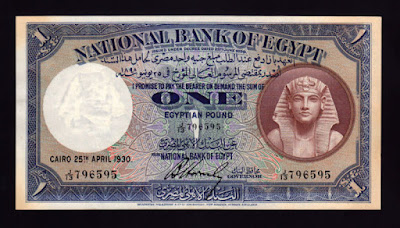 |
| Egypt banknotes E£1 Egyptian Pound King Tut banknote |
 |
| Egyptian Pound banknote |
Egyptian banknotes, Egyptian paper money, Egyptian bank notes, Egypt banknotes, Egypt paper money, Egypt bank notes
Obverse: Portrait of Tutankhamen most famous Ancient Egyptian pharaoh at right, circle over watermark at left, 25 April 1930 date under watermark.
Reverse: Mosque in Cairo at center
Watermark: Sphinx. Size: 161 x 85 mm
Printed by Bradbury Wilkinson and Company, New Malden in Surrey, England.
Tutankhamun was an Egyptian pharaoh of the 18th dynasty (ruled ca. 1332 BC – 1323 BC in the conventional chronology), during the period of Egyptian history known as the New Kingdom. He is popularly referred to as King Tut. His original name, Tutankhaten, means "Living Image of Aten", while Tutankhamun means "Living Image of Amun". In hieroglyphs, the name Tutankhamun was typically written Amen-tut-ankh, because of a scribal custom that placed a divine name at the beginning of a phrase to show appropriate reverence. He is possibly also the Nibhurrereya of the Amarna letters, and likely the 18th dynasty king Rathotis who, according to Manetho, an ancient historian, had reigned for nine years—a figure that conforms with Flavius Josephus's version of Manetho's Epitome.
The 1922 discovery by Howard Carter and George Herbert, 5th Earl of Carnarvon of Tutankhamun's nearly intact tomb received worldwide press coverage. It sparked a renewed public interest in ancient Egypt, for which Tutankhamun's burial mask remains the popular symbol. Exhibits of artifacts from his tomb have toured the world.